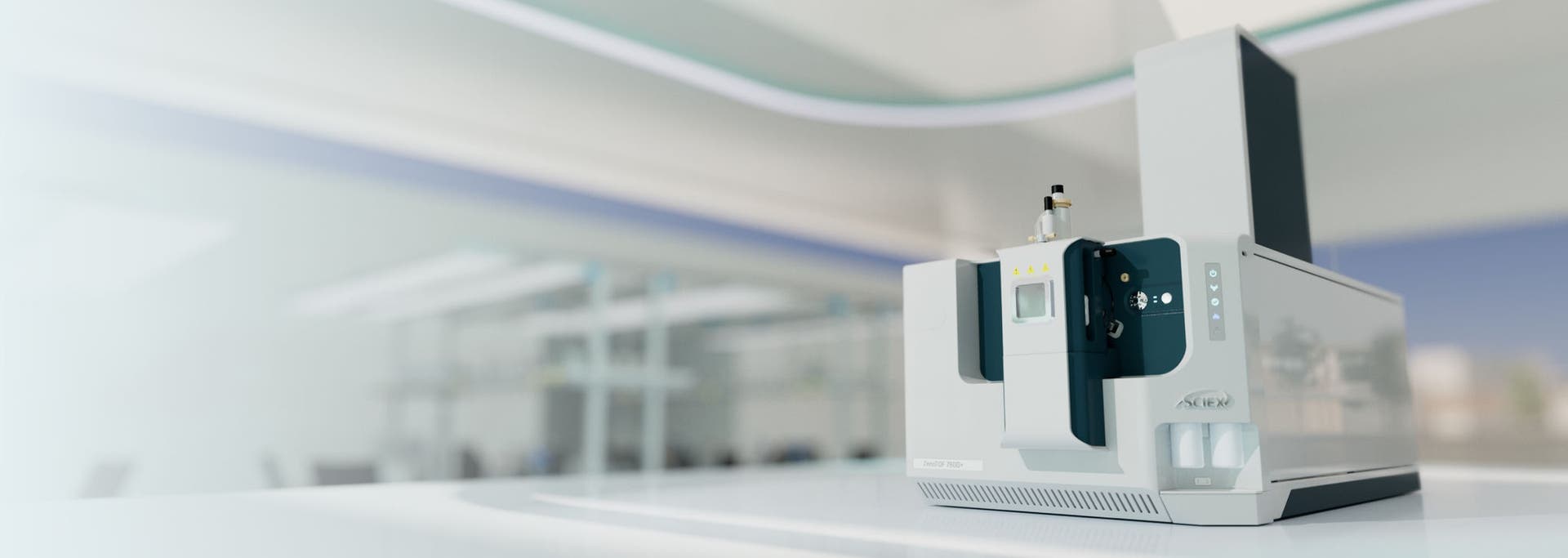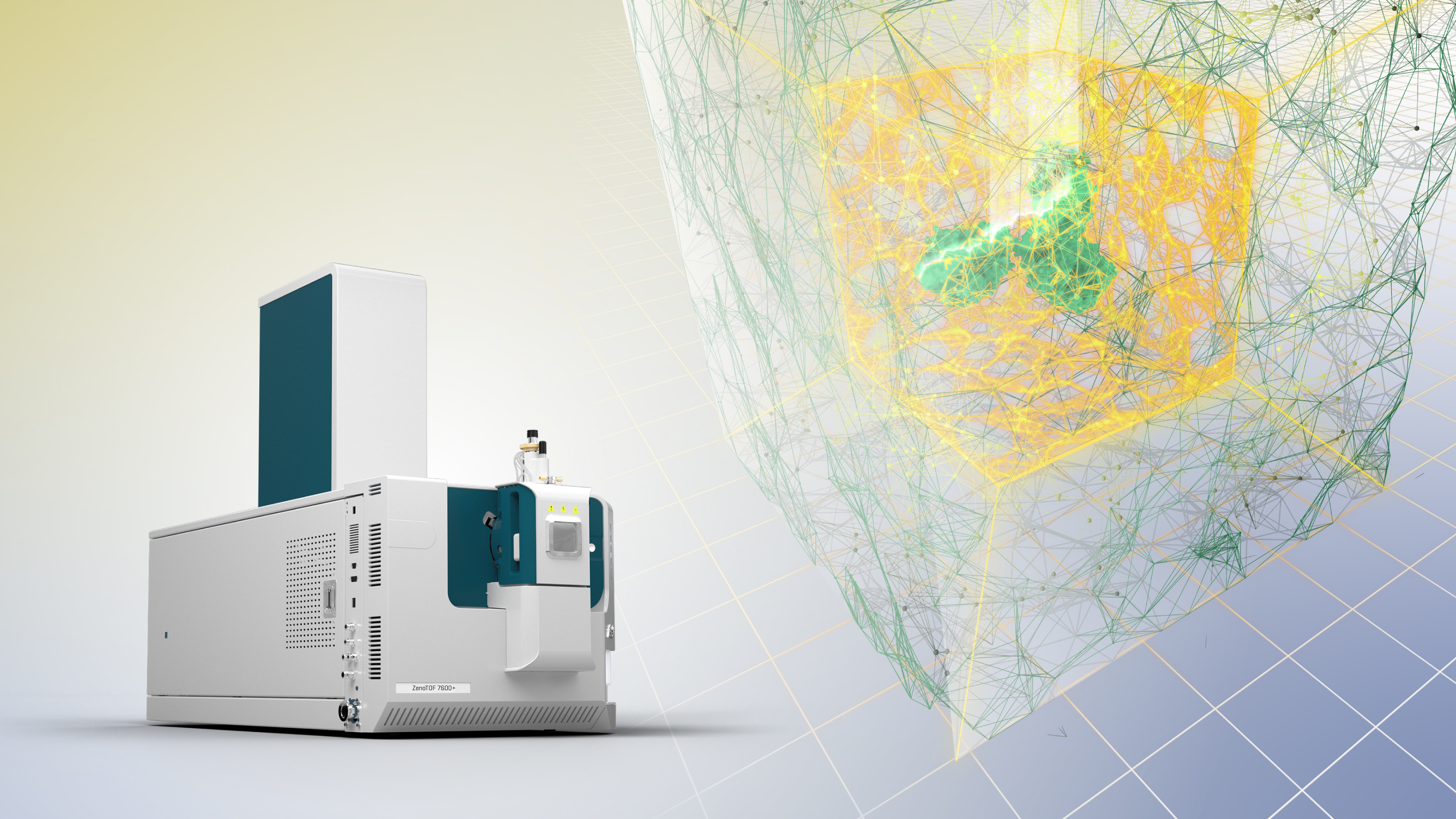The SCIEX ZenoTOF 7600+ system is a versatile, high-resolution QTOF with high sensitivity and outstanding quantitative and qualitative performance, empowered by Zeno trap activation, tunable EAD fragmentation, Zeno SWATH DIA, and ZT Scan DIA.

When you need to make crucial therapeutic pathway decisions, you need multi-dimensional, multi-acquisition certainty.
The decisions you make count. Whether confirming a biomarker as the right target or validating a new translational biomarker for drug discovery, determining the pathway for biotherapeutic efficacy demands timely and precise decisions.
Welcome to the future of transformative biology, where the numbers that count are the seconds from data to insight, the accuracy and precision of molecular insights, and the cost of efficiency.
Continuing the (r)evolution in quantitative accuracy
The SCIEX ZenoTOF 7600+ system takes quantitative accuracy to the next level. This high-resolution mass spectrometry solution combines powerful MS/MS sensitivity, fragmentation-centric technology, and innovative developments in data independent acquisition (DIA) approaches.
The ZenoTOF 7600+ system offers the selectivity of the scanning quadrupole dimension and high-quality MS/MS enabled by Zeno trap activation, for simultaneous quantitation and structural elucidation with unit-resolution in the Q1 dimension, enabling precision data acquisition in a single run.
Zeno trap-enabled DIA
A step change in SWATH data independent acquisition (DIA), leveraging the advanced technologies of Zeno SWATH DIA and ZT Scan DIA for an increase in biological insights, speed of analysis and accuracy of results.
Tunable electron fragmentation of all molecule types
Fast, reagent free and easy to use, electron activated dissociation (EAD) offers complementary fragmentation information to further extend analytical capabilities.
Scanning speeds of up to 640 Hz
High duty cycles at faster acquisition speeds. For larger cohorts, this can achieve up to 10 times the throughput of conventional DIA approaches without compromising data quality.
TwinSpray and Optiflow Turbo V sources
Dual sources to enable all flow rates with reliability and flexibility.

Expand your limits - Versatility opens doors to new potentials and novel insights
In biomarker research, scientists often struggle to translate insights into actionable data because of the trade-off between data depth and measurement quality. Traditionally, researchers faced the dilemma of prioritizing sensitivity and specificity to improve accuracy or sacrificing precision and data quality to increase identification rates.
Now with the ZenoTOF 7600+ system, take advantage of the extended range of technologies to achieve highly confident results using multi-faceted approaches. Utilize Zeno trap activation to increase the sensitivity and dynamic range of your data acquisition while elucidating structural information and detailed characterization using tunable EAD. Then, increase the depth, accuracy, and reproducibility of your analysis by employing Zeno trap-enabled DIA technology, such as Zeno SWATH DIA or ZT Scan DIA.
Zeno trap-enabled DIA
Dive deeper into the biomarker landscape. Zeno trap-enabled DIA technology makes a significant step-change in data independent acquisition, delivering a high depth of coverage, particularly on low-abundance species, quickly and robustly.
The combination of the Zeno trap with SWATH DIA acquisition methods, including discrete variable window (Zeno SWATH DIA) and scanning window (ZT Scan DIA), enables significant sensitivity gains by extending the duty cycle and dynamic range to enable researchers to confidently identify up to twice the number of plasma proteins than previously possible.
With the increase in acquisition speed, Zeno SWATH DIA and ZT Scan DIA facilitate large-scale biomarker studies by achieving optimal results in even less time, without compromising the depth and quality of data. Zeno trap-enabled DIA delivers the deepest level of data in the shortest time.
Target, validate and translate with ZT Scan DIA
Whether confirming a biomarker as the right target or validating a new translational biomarker for drug discovery, determining the pathway for biotherapeutic efficacy demands timely and precise decisions.
Biology beyond protein ID
For quantitative proteomics, ZT Scan DIA bridges the gap between protein identification and translation, enabling you to make informed decisions based on quantitation at unparalleled speed, accuracy and precision.
With the added dimension of data from quadrupole scanning, ZT Scan DIA brings certainty to your research, enabling precise decisions on which protein biomarker to validate and which therapeutic pathway to choose.
Biological relevance at speed
Translational certainty requires a depth of proteome coverage that can be accurately validated at scale.
ZT Scan DIA data allows you to precisely quantify proteins with no compromise in depth or coverage. With up to 10-fold improvement in throughput for protein quantitation, ZT Scan DIA enables 1-minute analyses for low to moderate protein loads.
Biological nuances unlocked
In biomarker discovery and development, low protein load analysis exposes measurement vulnerabilities, increasing the need for precision and reducing margins of error.
With ZT Scan DIA, navigate these risks with up to 9 fold increase in protein coverage at low loads. This enhanced protein coverage will help you negate those frailties with increased certainty to make precise decisions.
Above is a summary of the improvements in protein coverage depth with ZT Scan DIA, represented by the fold-change gain in overall sequence coverage per protein (A), the differential in actual sequence coverage per protein (B), and the change in number of amino acid residues identified per protein (C) using ZT Scan DIA relative to Zeno SWATH DIA. ZT Scan DIA extends protein characterization depth through higher confidence identifications of peptides, particularly those from lower abundance proteins.
(Mixed species sample: human (HEK 293 + MCF7) + yeast + mouse + drosophila extract tryptic digest, acquired either with ZT Scan DIA method (750 Da/sec, 5 Da window) or Zeno SWATH DIA (65 variable-width windows))
Features
Identify and quantify significantly more analytes in a shorter time, with less sample and higher precision.
ZT Scan DIA
The powerful combination of DIA, Zeno trap, and added specificity of the scanning quadrupole dimension enhances depth and certainty in quantitative measurements.
Overcome QTOF MS/MS duty cycle deficiencies
Ions are accumulated in the Zeno trap before being rapidly pulsed into the TOF, allowing the detection of up to 20x more ions.
Scan speeds of up to 640 Hz
When using ZT Scan DIA, the isolation window for MS/MS slides along the m/z range of interest during each cycle. Based on a defined m/z range, scanning at 750 Da/s with a 5 Da sliding isolation window would yield a scan rate of 640 Hz.
Ionization Source
The Optiflow Turbo V ion source incorporates the reliability and efficiency of the Turbo V ion source while providing flexibility for quickly switching flow rates, including nanoflow regimes for the highest sensitivity.
Tunable electron fragmentation of all molecule types
Exclusive to SCIEX, the ability to tune electron kinetic energy to employ electron-activated dissociation (EAD) extends the utility of the approach to all molecule types.
Simplified workflows
ZT Scan DIA methods are easy to set up with minimal user optimization, making the ZenoTOF 7600+ system ideally suited for analyzing large sample cohorts.
Deliver on important timelines
With up to 10-fold improvement in throughput for protein quantitation, the ZenoTOF 7600+ enables 1-minute gradient analyses using ZT Scan DIA for low to moderate protein loads.
Detection
Performance gains with fast LC gradients on the ZenoTOF 7600+ system increase as sample loading and complexity increase when using ZT Scan DIA, with added specificity from the scanning quadrupole dimension.
Resources
-
Technical note
Improved proteomics performance at high throughput using ZT Scan DIA on the ZenoTOF 7600+ system
ZT Scan DIA enhances protein and peptide precursor ID by up to 70%, handles up to 500 samples per day and improves specificity in complex samples with fast LC gradients.
-
Technical note
Improved proteomics performance for low sample loadings using ZT Scan DIA on the ZenoTOF 7600+ system
ZT Scan DIA simplifies setup with pre-defined methods, enhances protein and peptide ID by up to 50% at sub-ng loadings and delivers results up to 3 times faster than conventional methods.
-
Technical note
Selecting optimal ZT Scan DIA acquisition methods on the ZenoTOF 7600+ system for quantitative proteomics
This technical note compares three ZT Scan DIA methods on the ZenoTOF 7600+ to help users select the appropriate method for their quantitative proteomics experiments.
-
Technical note
Improved protein sequence coverage and reduced protein identification FDR
With ZT Scan DIA, the ZenoTOF 7600+ system enhances protein sequence coverage and identification confidence. Achieving up to 7-fold better protein sequence coverage and lower FDR, it outperforms conventional DIA methods.
Related products
Extraordinary discoveries demand extraordinary proof. The SCIEX ZenoTOF 8600 system combines proven technology from our most sensitive triple quad with that of our most versatile Zeno trap-enabled QTOF. Delivering up to 10x improvements in sensitivity* means achieving lower limits of quantitation and enabling enhanced performance across a multitude of accurate mass workflows.
* Compared to the ZenoTOF 7600+ system
The instrument that began the Zeno revolution. The ZenoTOF 7600 is a high-resolution mass spectrometry solution powered by the Zeno trap, coupled with tunable electron-activated dissociation (EAD) fragmentation technology. Your workhorse for everything from untargeted to comprehensive quantitative analyses to in-depth structural characterization.
Setting a new standard for instrument resilience and robustness, the SCIEX 7500+ system gives you the confidence to face evolving analytical challenges. Take on tight timelines with exceptional sensitivity and with the power to control your instrument downtime.
Streamline your workflows and accelerate delivery with software designed for all the latest SCIEX mass spectrometry systems—now enhanced with Windows 11 support to meet IT security policies and reduce cybersecurity risks.
Get high-quality data, analytical flexibility and high sample throughput so you can make informed decisions. The Echo® MS+ system is a complete solution that removes bottlenecks in high-throughput analytical workflows, from sample preparation to data reporting.

Comprehensive charge variant analysis made simple. The Intabio ZT system couples icIEF separation and UV detection with high-resolution mass spectrometry for peak identification.
Simple, plug-and-play nanoflow capability with cutting-edge features maintains the perfect balance of robustness and sensitivity.
Keep your instruments performing at their peak with multiple options for response time, repair coverage and maintenance.
Let's connect
Stay up-to-date with omics conversations on LinkedIn














